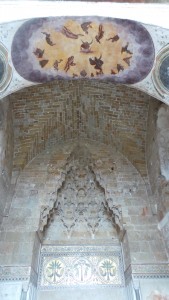Jet-lagged, hungry, and admittedly a bit cranky, our first day in Sicily was doubtlessly a daze for all. The architectural wonder that is La Zisa certainly did not subtract from our conviction that this trip was but a dream and Sicily a fantasy land.
Derived from the Arabic term “al-aziza” meaning “the gorgeous,” La Zisa was built in the twelfth century and designed to serve as a summer retreat for the Norman Kings ruling Sicily at that time. The partnership between the Norman King William I, who financed the construction, and the Arab architects responsible for the Islamic architecture demonstrates how eagerly the Normans appropriated the style of the pre-existing Arabic culture. An example of such Moorish decoration can be seen in the main hall. Throughout the palace but notable here in the main hall are cavities in the wall filled with Arabic stalactite work, a typical Islamic ornamental design known as mocárabe.
 Interestingly, on the ceiling of the main hall was a painting featuring several Classical gods, demonstrating the eclectic design of the palace due to the many rulers throughout Sicily’s history. Some of the gods and goddesses painted on the fresco can be recognized by their famous attributes: Poseidon brandishing his trident, Phoebus with his lyre, Mercury with his caduceus, winged sandals, and winged cap, Minerva dressed in her warrior garb, Hercules with his club and lion skin, the nude Venus with her naked son Cupid, and the blacksmith Vulcan with his hammer.
Interestingly, on the ceiling of the main hall was a painting featuring several Classical gods, demonstrating the eclectic design of the palace due to the many rulers throughout Sicily’s history. Some of the gods and goddesses painted on the fresco can be recognized by their famous attributes: Poseidon brandishing his trident, Phoebus with his lyre, Mercury with his caduceus, winged sandals, and winged cap, Minerva dressed in her warrior garb, Hercules with his club and lion skin, the nude Venus with her naked son Cupid, and the blacksmith Vulcan with his hammer.